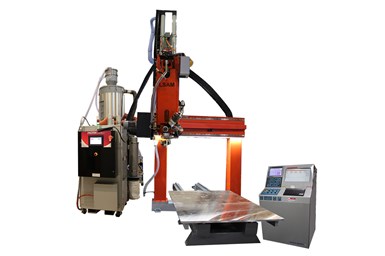Thermwood LSAM 510 Additive Printer Useful for Molding, Tooling
RAPID 2022: Thermwood’s LSAM 510 additive printer features a single fixed gantry and a 5 × 10 ft. moving table with a 4 ft. maximum print height and a maximum temperature of 450°C.

Thermwood’s LSAM 510 additive printer
Thermwood’s LSAM 510 additive printer is a Large-Scale Additive Manufacturing (LSAM) thermoplastic composite system designed for high-temperature printing, including the production of autoclave aerospace tooling.
The LSAM 510 features a single fixed gantry and a 5 × 10 ft. moving table with a 4 ft. maximum print height and a maximum temperature of 450°C. This print-only machine comes standard with a single dryer hopper, while dual dryer hoppers are optional for applications that change materials often. Thermal sensor automation is another optional feature, which automates the print process to easily and automatically obtain the highest quality layer-to-layer fusion.
The machine is said to include a powerful control and unique additive print features. It also comes standard with a system for drying and conveying pelletized polymer material as well as a liquid chilling system to maintain temperature control on vital systems. This is especially important when processing high-temperature material. Its 40-mm print head can print up to 100 lbs per hour.
The Thermwood LSAM line of large-scale, dual-gantry, “print and trim,” near-net-shape additive manufacturing (AM) systems are said to use an advanced print technology that produces high-quality, fully fused products from a wide variety of reinforced composite thermoplastic polymers, including materials that process at high temperature such as PSU, PESU and PEI, the company says. These systems are being used primarily for producing molds and tooling, including aerospace and industrial production applications.
Related Content
-
Aircraft Ducts 3D Printed in Composite Instead of Metal: The Cool Parts Show #68
Eaton’s new reinforced PEKK, tailored to aircraft applications, provides a cheaper and faster way to make ducts compared to formed aluminum.
-
What Does Additive Manufacturing Readiness Look Like?
The promise of distributed manufacturing is alluring, but to get there AM first needs to master scale production. GKN Additive’s Michigan facility illustrates what the journey might look like.
-
Airless Basketball Shows Promise of 3D Printed Lattices: The Cool Parts Show Bonus
Successfully matching the performance of a standard basketball demonstrates the control possible over the mechanical properties of digital materials.










